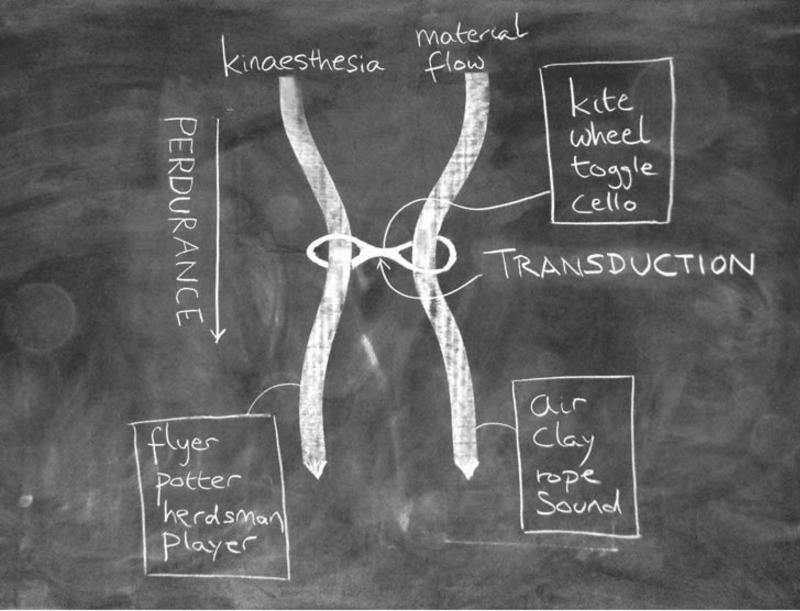-
Title
-
Transduction and perdurance
-
Description
-
The movement of kinaesthetic awareness (respectively of the flyer, the potter, the herdsman and the player) is converted by way of a transducer (respectively kite, wheel, toggle and cello) into a corresponding flow of material (respectively of air, clay, rope and sound). In terms of this diagram, the perdurance – or ‘carrying on’ – of awareness and materials runs downwards, while transduction couples across. Chalk on blackboard. In the dance of animacy, cello, toggle, kite and wheel are all examples of what we could call transducers.4 That is to say, they convert the ductus – the kinetic quality of the gesture, its flow or movement – from one register, of bodily kinaesthesia, to another, of material flux. In the vibration of bowed strings, amplified by a soundbox, the cellist’s manual gesture is rendered audible, as melody. In the sliding of the toggle, the herdsman’s throw is cast as a loop of rope. In the rotation of the wheel, the potter’s hand and finger movements are registered in the contours of soft clay. And finally, in the kite, slicing the air like an axe through wood, following its undulations and torsions, the running of the flyer becomes a line of flight. In each case, the transducer slides along the thread of time, like a toggle on a rope, ever present on the threshold of emergence of things. It is this ever-presence that lends it an aura of immutability (See Figure).
-
Designer
-
Ingold, Tim
-
Ingold, Susanna
-
Date
-
2013
-
Source
-
Making: Anthropology, Archaeology, Art and Architecture
-
Bibliographic Citation
-
Ingold, Tim. 2013. Making: Anthropology, Archaeology, Art and Architecture. Routledge: Taylor and Francis Group. Figure 7.7. Pages 102-103.
-
is composed of
-
English
Square
-
English
Spiral
-
has attribute
-
English
Arrow
-
English
Solid Line
-
depict things of type
-
English
Conceptual
-
English
Cyclical
-
Coverage
-
anthropology
 Ingold-Transduction.png
Ingold-Transduction.png